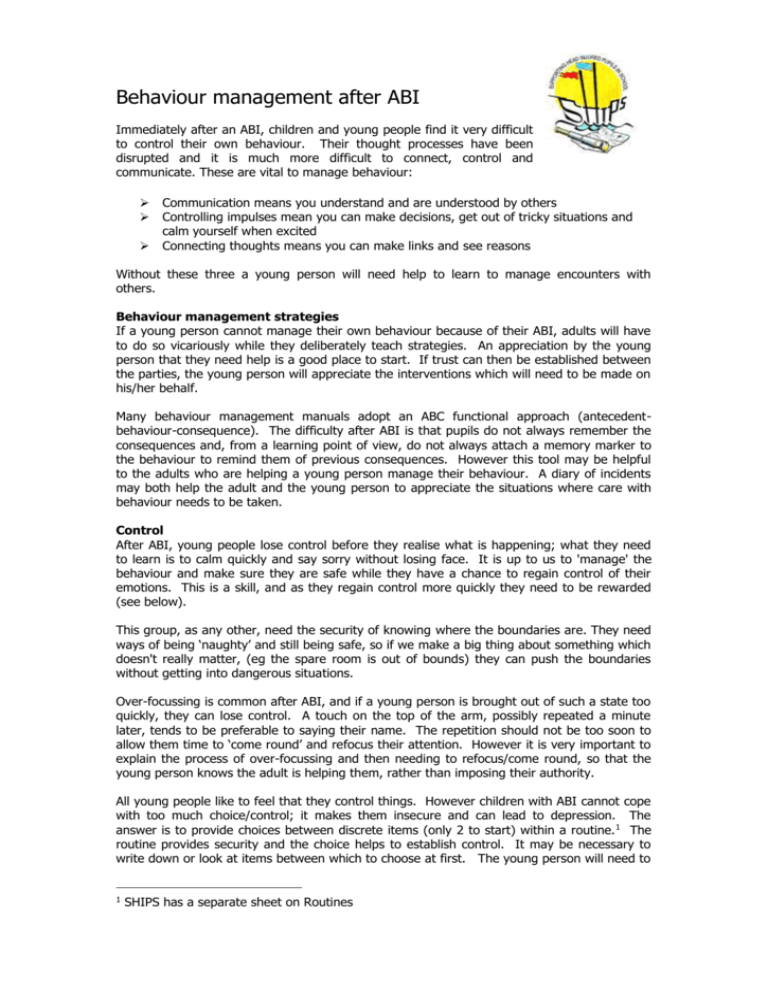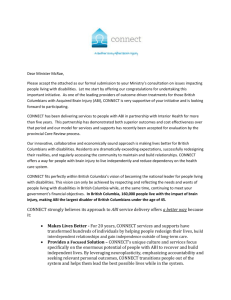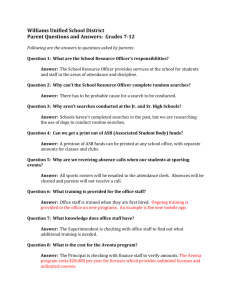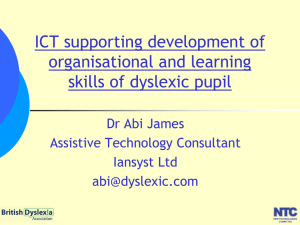Behaviour management after ABI
advertisement

Behaviour management after ABI Immediately after an ABI, children and young people find it very difficult to control their own behaviour. Their thought processes have been disrupted and it is much more difficult to connect, control and communicate. These are vital to manage behaviour: Communication means you understand and are understood by others Controlling impulses mean you can make decisions, get out of tricky situations and calm yourself when excited Connecting thoughts means you can make links and see reasons Without these three a young person will need help to learn to manage encounters with others. Behaviour management strategies If a young person cannot manage their own behaviour because of their ABI, adults will have to do so vicariously while they deliberately teach strategies. An appreciation by the young person that they need help is a good place to start. If trust can then be established between the parties, the young person will appreciate the interventions which will need to be made on his/her behalf. Many behaviour management manuals adopt an ABC functional approach (antecedentbehaviour-consequence). The difficulty after ABI is that pupils do not always remember the consequences and, from a learning point of view, do not always attach a memory marker to the behaviour to remind them of previous consequences. However this tool may be helpful to the adults who are helping a young person manage their behaviour. A diary of incidents may both help the adult and the young person to appreciate the situations where care with behaviour needs to be taken. Control After ABI, young people lose control before they realise what is happening; what they need to learn is to calm quickly and say sorry without losing face. It is up to us to 'manage' the behaviour and make sure they are safe while they have a chance to regain control of their emotions. This is a skill, and as they regain control more quickly they need to be rewarded (see below). This group, as any other, need the security of knowing where the boundaries are. They need ways of being ‘naughty’ and still being safe, so if we make a big thing about something which doesn't really matter, (eg the spare room is out of bounds) they can push the boundaries without getting into dangerous situations. Over-focussing is common after ABI, and if a young person is brought out of such a state too quickly, they can lose control. A touch on the top of the arm, possibly repeated a minute later, tends to be preferable to saying their name. The repetition should not be too soon to allow them time to ‘come round’ and refocus their attention. However it is very important to explain the process of over-focussing and then needing to refocus/come round, so that the young person knows the adult is helping them, rather than imposing their authority. All young people like to feel that they control things. However children with ABI cannot cope with too much choice/control; it makes them insecure and can lead to depression. The answer is to provide choices between discrete items (only 2 to start) within a routine. 1 The routine provides security and the choice helps to establish control. It may be necessary to write down or look at items between which to choose at first. The young person will need to 1 SHIPS has a separate sheet on Routines be told that they have to choose for themselves. If they always choose the last item which you mention, they are not really choosing and will need further help to focus on the choice they are making. Communication Communication is frequently the key to managing behaviour; in school, books may be thrown across the room when the pupil has come to the end of his/her patience with a difficult task. It may be suggested that they ‘could have spoken to the teacher’, but perhaps they may not be able to find the words. This can also make the young person feel very insecure; without a ‘label’ we cannot think about ideas, make links and find a solution to the current problem. After ABI many young people do find great difficulty in expressing their ideas clearly and much of the unhelpful behaviour stems from this. It follows from this that we need to understand the purpose of the behaviour we find unacceptable, communicate clearly and teach appropriate ways to express frustration, or desires, rather than to punish. These ways should be 1. Easy - otherwise the pupil will revert to the easier, unacceptable behaviour 2. Effective - adults must take notice Thumbs up and down in response to adults’ questions may be all that a young person can manage in an excitable state and we need to accept this. It may be that for some young people symbolic notation, eg PECS or Makaton, would be helpful; a Speech and Language Therapist may be able to advise on the best approach. It is also helpful to talk about how characters feel in stories, moving from the broad brushstroke words eg sad, happy, angry, to more nuanced words, differentiating between cross, angry and livid for example. Then the young person would have the label (word) to express more precisely how they are feeling. It may also help to adopt a scale of 1 to 10; on a scale of 1 to 10 how angry do you feel? The adult and child can then agree a level at which the child will step out of his/her activity and regain their emotional control. Connections There is also an assumption in the ABC model that the young person understands cause and effect, can generalise and accepts delayed consequences; this is not always the case after ABI. Any consequences to an action have to happen immediately. Rewards have to be easy to win and easy to lose, and if one is lost no record of it must remain - not even a sticky mess! Velcro backed stars work well as do marbles or stones in a jar. In the latter case you can have a big stone or a little stone, big jar for a big reward or little jar for a little one which is earned quickly, but there must be a rule about who can put them on the chart or in the jar. If the child awards himself the stars without adult supervision this is not helpful. The advantage of a jar is that you can gradually talk about looking further forward for a reward - eg GCSEs, or a job, or whatever. Aiming towards a list of treats is generally too much. The scheme must aim for one at a time. Because of memory difficulties the adult will probably need to write out the reward and also the ‘price’ - 10 stars or a full jar or whatever. If you let the child suggest a long list, his/her memory will play tricks and he/she will expect all of them. Stars have to be for positive things; not losing your temper is negative but calming down quickly is positive. For example, there could be a reward for turning off the TV when asked first time, or sitting down immediately when asked in the classroom. That could happen umpteen times a day and reinforce the point. Teaching strategies Establishing rules Rules can be difficult after ABI because of the need to generalise within different contexts. With a pupil who has ABI adults have to be very explicit in setting rules. For example I find the poster ‘10 ways to manage anger’ is too vague. It is fine for a young person who knows what is happening but has difficulties with management, but after ABI the child does things without realising. Working with ABI, I know that 'don't' is forgotten and young people 'do' whatever the 'don't' was, so any commandments must be positive. But the young person will need a cue card to remember any ‘rules’ which have been agreed, and the willingness to use it at a time when the tension inside is getting too much. Rights and responsibilities If we teach about rights we must teach that rights have their corresponding responsibilities. A young person has a right to express their feelings, but a responsibility not to hurt others, physically or mentally. After an ABI this is difficult to appreciate because of the difficulties with empathy and with thinking of two things at the same time. It is also difficult to appreciate hurt when that hurt is not visible. Social stories Social stories are excellent ways to make ideas concrete. They help a young person remember the teaching point, especially if there are illustrations to look at while the story is told. However it is unlikely that the young person will be able to generalise without help and it will be necessary to couch the same teaching points in several contexts and ask the young person what is the same about them in order to help the process of abstraction. Questioning approach Young people may find it helpful to ask themselves the following questions to reduce impulsive behaviour What is happening? (goal) How shall I do it? (plan) What is hard/easy? (obstacles) How can I tackle it? (strategies) Do it How did it go? (review) However to establish these questions it will require them to be written down in an accessible place, eg planner or laminated crib card to be kept in a pocket. Reminders After ABI, young people rarely learn by picking things up, or ‘osmosis’. They will need acceptable ways of behaving spelled out to them, with phrases to use in particular situations, as a positive behavioural support. These could be written in the back of a planner. The young person may need a constant reminder, perhaps as a wristband, or necklace, to help them think about the issue. For example, it has been found that ‘tagging’ is very effective for young people with ABI who get in trouble with the law, possibly as they have a constant behavioural reminder on them at all times. Not that I am suggesting for one moment that all young people with an ABI should be tagged! Peer Support/Circle of Friends The support of peers can be helpful; a buddy system or a ‘circle of friends’ may be set up, to talk through issues, but I have also found that for some young people this can be counterproductive as friends gradually drift away and cannot cope with the responsibility they are asked to shoulder. The choice of ‘friends’ and a good understanding of their characters and positions is extremely important. Other young people with an ABI do not want their difficulties shared even with their friends and this can be a sensitive issue. The best examples of a buddy system working was where it was mutual and both young people were made aware of the other’s weaknesses and asked to support their friend. I hope that this sheet is helpful in thinking through the issues which face your child/pupil. Any feedback would be welcome.






